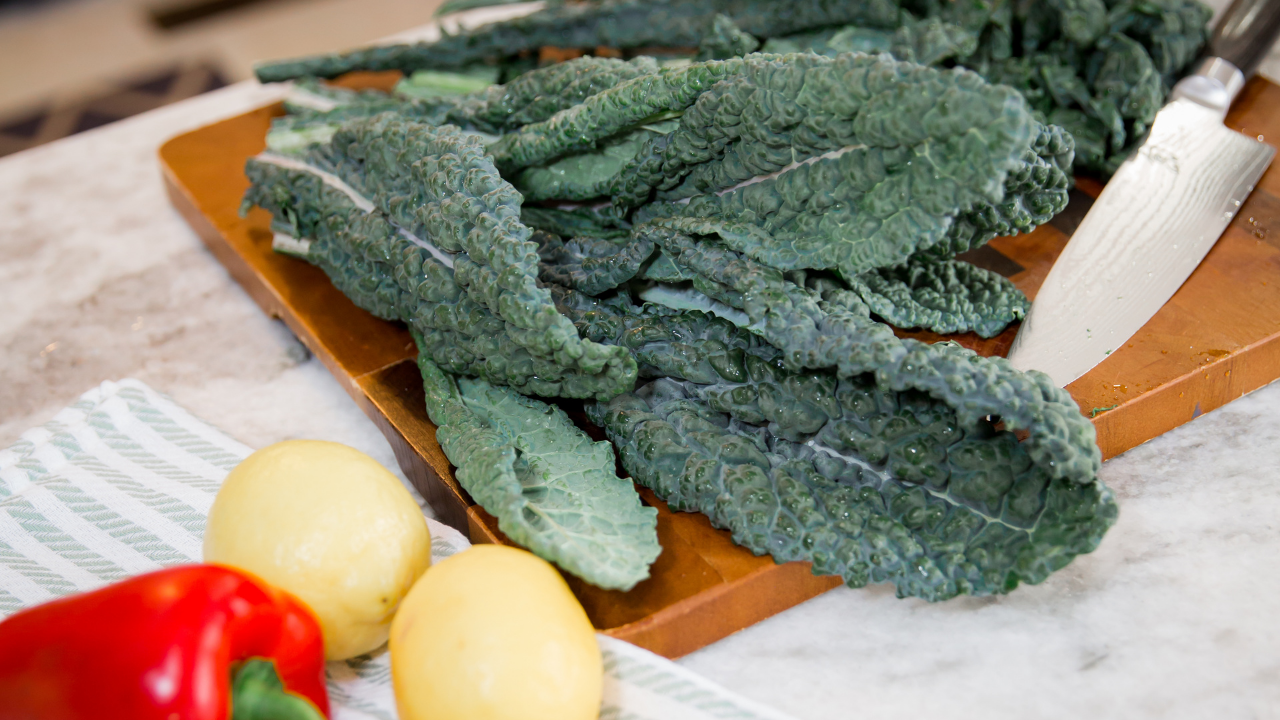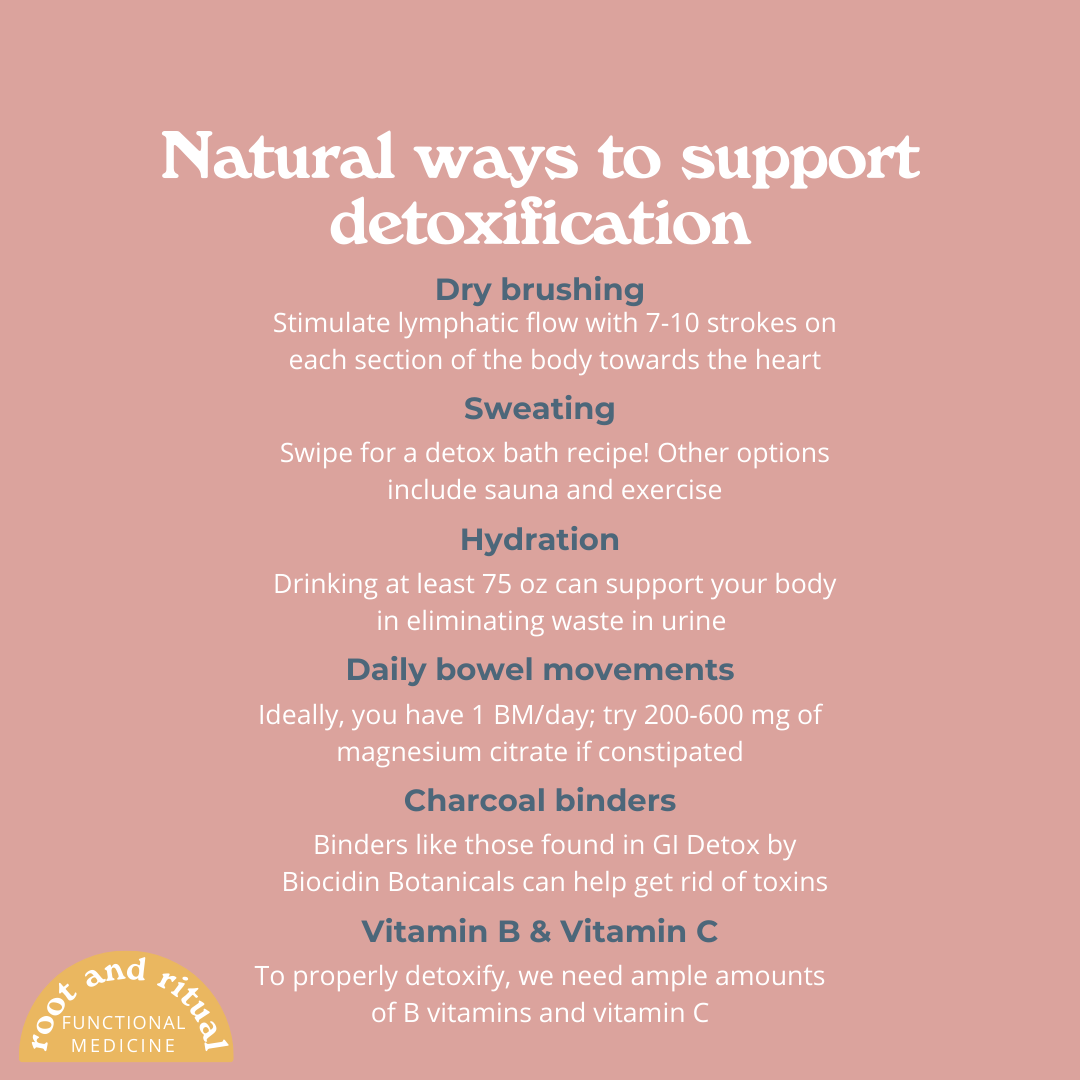
How to Support Your Body's Detox Pathways Naturally
Jun 26, 2022If you believe you need to go on crazy restrictive diets, drink celery juice, or purchase expensive teas to support detoxification, then you’re in the wrong place, friend. Wait, that’s not true. You’re actually in the right place! Come with me and let me show you the light. There is a better way to support your gut and liver and gently encourage detoxification. In this post, you’ll learn the three phases of detoxification, symptoms of toxicity, and ways to support the body’s detoxification pathways naturally. Grab a cup of tea or coffee (they both support detoxification!) and enjoy a mini deep-dive into the biochemistry of detoxification.
Overview of the Body's Detoxification Pathways
One of the five core functions of the GI tract is the elimination of toxins. The gut accomplishes this through the gut-liver axis. The body eliminates waste products from undigested food, bile, and dead bacterial cells, but it’s also charged with removing byproducts from metabolism (such as hormones, like estrogen) as well as environmental toxins. The gut-liver axis is truly a powerhouse! Ultimately, what we don’t use or no longer need must be removed from our bodies and detoxification is how this is accomplished.
The liver utilizes a two-step process, phase I and phase II detoxification, to create water-soluble compounds. Let me explain: most toxins must be transformed into a suitable compound before they can be eliminated through urine, stool, or sweat (or as I like to say it, “peeing, pooping, and sweating”). They need to become water-soluble AKA easily dissolved in water. Think about it this way: all forms of elimination (peeing, pooping, and sweating) involve water, so to utilize this route, the toxin must be water-soluble to hitch a ride out of the bladder, GI tract, or pores. Since many toxins are fat-soluble and not water-soluble, the liver is a busy organ.

Phase I is known as bioactivation and involves transforming a substance into an intermediate compound that is then ready for phase II. Many intermediate compounds formed from phase I can be more toxic than the original substance! This is why you should support all phases of detoxification.
The intermediate compounds are known as reactive oxygen species (ROS) or intermediates and require specific antioxidants to ensure they don’t cause damage before being shuttled off to phase II.
Phase II is known as conjugation and involves pairing a molecule with the intermediate metabolites so they are now water-soluble (easily dissolved in water). This allows them to be removed through urine, stool, or sweat. Phase II detoxification requires a large amount of energy (ATP) and many nutrients that must be obtained through diet or supplementation.
If someone does not have enough nutrients or energy for phase II detoxification, then they run the risk of creating reactive intermediate compounds that are stuck between phase I and II and these compounds can wreak havoc on the body and cause inflammation. This is why supporting your natural detoxification pathways in a specific order is important and you don’t do it by supporting phase I then phase II then phase III. The ideal way is to begin backwards by supporting elimination first, which is phase III. In other words, you make sure someone is pooping before you support the liver. As Tracy Harrison says, “You don’t flush a clogged toilet.” Get the bowels moving and things flowing first and then you can give extra nutrients to support the liver and detoxification pathways.
Toxic Overload: Signs and Symptoms
The human body is tasked with the enormous job of neutralizing a vast amount of toxins, hormones, and other waste products. The liver already had a monumental task prior to the introduction of manmade chemicals and toxins. Additionally, most people are deficient in nutrients, such as B vitamins, and these deficiencies can reduce the liver’s ability to eliminate toxins. It’s easy to see, then, how the body can become overwhelmed and disease can develop.
Certain presentations can reveal the likelihood of toxin burden. The following are overt signs and symptoms related to toxicity:
- Chronic fatigue syndrome
- Multiple chemical sensitivities
- Fibromyalgia
- Immune disorders
- Cognitive disorders and neuropsychiatric disorders
Conditions that may benefit from detoxification support:
- Frequent exposure to chemicals (caffeine, tobacco, alcohol, pharmaceuticals)
- Obesity/overweight
- Hormone-related imbalances
- Increased intestinal permeability (also known as leaky gut)
- HPA axis dysfunction (also known as adrenal fatigue)
- Digestion or elimination disorders
Certain toxins are stored in fat, so losing weight also presents a problem. On the one hand, you want the toxins gone, but on the other, you need to make sure you have a way to clear them out when you “free them” as you burn fat and lose weight.
Leaky gut can allow toxins to enter the body by way of the GI tract and overburden the liver’s detox capacity. Leaky gut plus a keto diet can result in symptoms similar to the flu as toxins “piggyback” on fats to enter the bloodstream and result in a mild form of endotoxemia.
A functional medicine provider may test for certain markers to determine if someone may be experiencing an issue with detoxification. One example would be testing a person’s glutathione level. Glutathione is one of the primary antioxidants in the body and required for part of phase II detoxification. Low levels of glutathione can indicate a low reserve available for detoxification. A provider may also check genetic tests, such as the MTHFR SNP to determine if that person may be genetically predisposed to difficulty with methylation during phase II detoxification. Beta glucuronidase activity can also be evaluated in a stool test. This enzyme affects estrogen metabolism and elevated levels of beta glucuronidase can play a role in estrogen dominance, fibrocystic breasts, and perhaps even breast cancer. Organic acids testing can also reveal markers of toxicity or detoxification impairments from the urine.

Supporting the Body's Detoxification Pathways
The first step in supporting the body’s ability to detoxify appropriately is to reduce the toxic burden. This should be the starting point in any protocol. Your provider may suggest an elimination diet, fasting, lifestyle changes, and/or supplements to help support your body’s detoxification pathways.
REDUCE/REMOVE
Environmental toxins:
- Pollution
- Auto exhaust
- Heavy metals
- Solvents (paint, cleaning products)
- Pesticides, herbicides, insecticides
- Radiation
- Inhalants
Lifestyle toxins:
- Dietary choices - fast foods, fried foods
- Artificial food additives, colorings, and preservatives
- Meats containing hormones and antibiotics
- Refined foods and sugars
- Cosmetics
- Nicotine
- Alcohol
- Caffeine (coffee can be a toxin but may also help promote detoxification, choose organic if you consume coffee)
- Prescription drugs
- Over-the-counter drugs (NSAIDs, Tylenol, etc.)
Internal toxins:
- Bacterial, yeast, or fungal overgrowth
- By-products of metabolism (carbon dioxide, ammonia)
- Undigested food
- Stress
- Unresolved trauma and abuse
- Toxic relationships

EMPHASIZE/ADD
Nutrition and Supplements to enhance phase III detoxification (elimination):
- Flax
- Psyllium
- Prunes
- Water
- Magnesium citrate
- Probiotics
Nutrition and Supplements to enhance phase I and II detoxification (liver support):
- Grapes, berries, pomegranate
- Cruciferous vegetables (broccoli, Brussels sprouts, cauliflower)
- Purple sweet potato
- Garlic, onion, leeks, chives
- Watercress
- Astaxanthin (salmon, shrimp, trout, algae)
- Fermented soy (tempeh, miso)
- Eggs
- Walnuts
- Ghee
- Rosemary
- Turmeric
- Green tea, rooibos tea
- Coffee
- Chicory root
Supporting detoxification with lifestyle & supplements:
- 12-16 hour fast (consult provider before fasting)
- Purchase organic food where possible (Clean 15 and Dirty 12)
- Treat dysbiosis and/or leaky gut
- Drink plenty of water
- Manage stress (yoga, acupuncture, walking, journaling, mindfulness)
- Dry brush
- Sauna or detox bath (see below!)
- Avoid antibiotics
- Increased protein intake
- Quercetin to support liver detoxification
- Indole-3-carbinol (I3C) and diindolylmethane (DIM) to support liver detoxification
- B-complex and vitamin C to support cellular energy production and liver detoxification
- Fish oil to support liver detoxification and decrease inflammation
- NAC, CoQ10, and acetyl L-carnitine to support cellular energy production
- Milk thistle and dandelion root to support bile production
- Charcoal to bind toxins
Detox Bath:
- 2 cups epsom salt
- 1/2-1 cup baking soda
- 1/2 cup bentonite clay
- 5-10 drops essential oils (I prefer lavender for relaxation)
- Stay in the tub for 30 minutes or at least until you begin to sweat from your temples

How might this look in real life?
- Early morning: water with electrolytes, walk or yoga, 5 minute meditation
- Breakfast: scrambled eggs with arugula and onions, side of grapes, green tea, supplements
- Lunch: salmon salad with walnuts, green tea
- Snack: smoothie with flax, frozen cauliflower, leafy greens, and berries
- Dinner: curry, side of broccoli
- Evening: dry brushing, detox bath, rooibos tea, supplements

It’s easy to see how a few strategic lifestyle and nutrition additions can support detoxification without any expensive powders, pills, or potions. Not to say you shouldn’t supplement - quercetin, curcumin, and fish oil can go a long way in supporting detoxification, but not everyone requires supplements. And don’t forget the old adage, you can’t out-supplement a “bad” diet.
In upcoming posts, we will review how you can decrease toxins in your home, skincare, and beauty products. Stay tuned!

